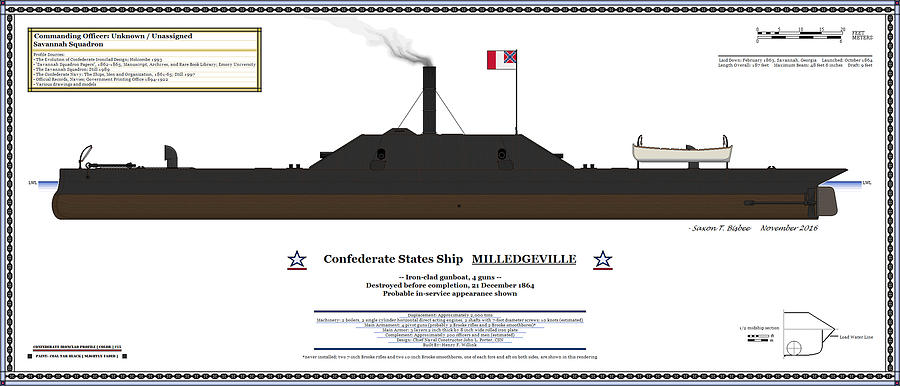
This one-of-a-kind vessel was a late-war design intended to be an improvement over the earlier standard hull types such as the Richmond class. As such, the Milledgeville had a similar hull structure to that of earlier ironclads but incorporated significant design changes. Fortunately, these changes are shown in extant plans of the ironclad bearing Constructor Porter’s signature. The Milledgeville was a twin-screw standard hull ironclad laid down in February 1863 by Henry Willink, the constructor of CSS Savannah and a prominent and skilled local shipbuilder. The new ironclad was 175 feet in length between perpendiculars, 185 feet in overall length, 35 feet 2 inches in molded beam, and 48.5 feet in extreme beam. It featured the late-war improvement of the flush deck design of the Columbia, which continued to flare up to main deck level instead of turning back at the waterline. This allowed for a wider main deck and more room for multiple pivot guns in the shortened casemate, which was covered with 6 inches of armor. Most important, the ship had a reduced draft of 9 feet.
The Milledgeville plans also show the general machinery arrangement of the ship, although its final configuration may have differed slightly. Unfortunately, like those of most other Confederate ironclads, the plans show little actual detail of the engines and boilers. Two circles scaled to approximately 30 inches in diameter representing single-cylinder horizontal engines are shown in the starboard plan view along with a boiler 14 feet long and 6 feet in diameter. Dimensions taken off the plans show that the Milledgeville had two boilers. Twin propellers 7 feet in diameter are shown at the stern. All the machinery was built by Columbus Naval Iron Works and should have given good service.
The Milledgeville’s completion was severely delayed, like many other Confederate ironclads. Willink’s prior commitments and design changes to the ship while under construction were the biggest factors. The Milledgeville was launched in the early fall of 1864 and was nearly complete when it was burned to prevent capture as Union forces under General Sherman reached Savannah on December 21, 1864. The ship was anchored and ready for towing out of harm’s way, but there were no vessels available to help. After removing some stores and readying the hulk for maximum destructive effect, the Confederates set fire to the ironclad; it was soon sunk.
The Milledgeville’s engines and most of its armor were installed by that time but were salvaged by the US Army Corps of Engineers in the 1890s. The current condition of the wreck is unknown—future archaeological surveys of the site may uncover new details.
A Comparative Analysis of Confederate Ironclad
A Comparative Analysis of Confederate Ironclad
Download